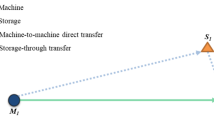Abstract
Test wafers are used to measure the process quality in semiconductor manufacturing. Test wafers are reusable by recycle cleaning and can be downgraded to the downstream processes. Most previous studies on test wafers aimed to reduce the use of test wafers by making appropriate operational decisions. Yet, the effective improvement of yield in the recycle process of test wafers is seldom explored. This paper formulates a decision problem and proposes two solution methods for selecting the yield improvement alternatives in the test wafer recycle processes. The decision problem is to determine the yield improvement target for each recycle process in order to minimize the use of test wafers, under a given budget for yield improvement. The two solution methods involve a genetic algorithm and a marginal allocation algorithm. The two methods yield very close solutions, but the marginal allocation method is better because it requires less computation time.
Similar content being viewed by others
References
Chen HC (2003) Control and dummy wafers management. Dissertation, National Chiao Tung University, Hsin-Chu, Taiwan
Chen JH, Fu LC, Lin MH, and Hunang AC (2001) Petri-net and GA-based approach to modeling, scheduling, and performance evaluation for wafer fabrication. IEEE Trans Robot and Automat 17(3):619–636
Chen HC, Lee CE (2000) Downgrading management for control and dummy wafers. J Chin Inst Ind Eng 17:437–449
Chu YF (1998) The inventory management model for control and dummy wafers. Dissertation, National Chiao Tung University, Hsin-Chu, Taiwan
Gen M, Cheng R (2000) Genetic algorithms and engineering optimization. Wiley, New York
Foster B, Meyersdorf D, Padillo JM, and Brenner R (1998) Simulation of test wafer consumption in a semiconductor facility. IEEE/SEMI Advanced Semiconductor Manufacturing Conference, pp 298–302
Holland JH (1975) Adaptation in neural and artificial systems. Univ Michigan Press, Ann Arbor, MI
Lu KS (2003) Decisions for downgrading control/dummy wafers in semiconductor fabs. Dissertation, National Chiao Tung University, Hsin-Chu, Taiwan
Popovich SB, Chilton SR, and Kilgore B (1997) Implementation of a test wafer inventory tracking system to increase efficiency in monitor wafer usage. IEEE/SEMI Advanced Semiconductor Manufacturing Conference, pp 440–443
Rietman EA and Frye RC (1996) A genetic algorithm for low variance control in semiconductor device manufacturing: some early results. IEEE Trans Semicond Manuf 9:223–229
Watanabe A, Kobayashi T, Egi T, and Yoshida T (1999) Continuous and independent monitor wafer reduction in DRAM fab. IEEE International Symposium on Semiconductor Manufacturing Conference, pp303–306
Winston PH (1992) Artificial Intelligence. Addison-Wesley, Boston, MA pp 520–527
Wong CY, Hood SJ (1994) Impact of process monitoring in semiconductor manufacturing. IEEE/CPMT International Electronics Manufacturing Technology Symposium, pp 221–225
Wu JE (1997) The construction of dispatching rule for control wafer in diffusion area. Dissertation, National Chiao Tung University, Hsin-Chu, Taiwan
Author information
Authors and Affiliations
Corresponding author
Rights and permissions
About this article
Cite this article
Wu, MC., Chien, C. & Lu, K. Yield improvement planning for the recycle processes of test wafers. Int J Adv Manuf Technol 27, 1228–1234 (2006). https://doi.org/10.1007/s00170-004-2316-z
Received:
Accepted:
Published:
Issue Date:
DOI: https://doi.org/10.1007/s00170-004-2316-z




